24 Hours Hotline: +86 137-3541-1378
Email:[email protected]
24 Hours Hotline: +86 137-3541-1378
Email:[email protected]
Introduction
Qianmen Street is one of Beijing’s most iconic commercial and cultural thoroughfares, offering a fascinating blend of history and modernity. Stretching over 800 meters, this pedestrian-friendly street showcases traditional Chinese architecture alongside contemporary shops, cafes, and entertainment venues. Visitors can stroll past well-preserved historic buildings, enjoy local delicacies, and experience the lively atmosphere that has made Qianmen a must-visit destination. Beyond shopping and dining, Qianmen Street is steeped in history, once serving as a bustling marketplace during the Ming and Qing dynasties. Its notable landmarks, such as Zhengyangmen Gate and historic teahouses, provide insight into Beijing’s past, while street performances and seasonal festivals add a dynamic, cultural dimension. This combination of heritage, culture, and modern leisure makes Qianmen Street a truly immersive experience for history lovers, foodies, and culture enthusiasts alike.


Historical Background
Qianmen Street traces its origins back to the Ming and Qing Dynasties, serving as the main commercial artery just outside the iconic Zhengyangmen Gate. Over the centuries, it played a pivotal role in Beijing’s urban growth and economic development, bustling with merchants, craftsmen, and entertainers. Traditional shops, theaters, and teahouses lined the street, creating a vibrant hub where locals and visitors mingled. Famous establishments such as historic candy stores, traditional Beijing snack vendors, and century-old boutiques became landmarks in their own right. Stories of emperors, scholars, and legendary performers are woven into the street’s past, giving Qianmen a rich cultural tapestry that continues to captivate visitors today. Today, Qianmen has been carefully restored to preserve its historical charm while accommodating modern shops, restaurants, and cultural attractions, making it a perfect blend of heritage and contemporary life.
.jpg)
.jpg)
Architectural Highlights
Qianmen Street is a showcase of Beijing’s rich architectural heritage, where traditional design coexists harmoniously with modern updates. Walking along the street, visitors can admire well-preserved historical buildings, intricate decorative details, and the unique layout that reflects centuries of Chinese urban planning. The careful restoration maintains the charm of the Ming and Qing dynasties while allowing for contemporary commercial and cultural use. From the red-brick façades to the tiled rooftops and ornamental eaves, every corner tells a story of craftsmanship, culture, and urban evolution. This architectural blend provides a visually captivating experience, highlighting the city’s commitment to preserving its past while embracing the present, and allows visitors to feel a direct connection to Beijing’s historical and cultural identity.
1. Preservation of Traditional Beijing “Siheyuan” Courtyard Architecture
Many buildings along Qianmen Street retain the classic “Siheyuan” layout, featuring enclosed courtyards surrounded by symmetrical rooms. These traditional structures offer a glimpse into the residential and commercial life of historical Beijing, with ornate roofs, wooden beams, and inner gardens. Visitors can appreciate the balance between functionality and aesthetic elegance that has defined Beijing’s architecture for centuries. Walking through these courtyards, one can see how spaces were used for both family life and small businesses, with rooms carefully arranged for privacy, commerce, and social gatherings, reflecting the social structure and daily routines of the time. In addition, some courtyards feature decorative stone pathways, engraved door panels, and small garden ponds, which demonstrate the attention to detail and the blending of nature and living space, offering an immersive experience of traditional urban life.
.jpg)
.jpg)
2. Notable Gates and Archways, Including Zhengyangmen (Qianmen Gate)
Qianmen Street is anchored by several iconic gates and archways, with Zhengyangmen (Qianmen Gate) being the most prominent. Originally part of Beijing’s city wall, this historic gate served as a vital entry point and symbol of the city’s power and prestige. Its imposing structure and detailed carvings make it a must-see landmark, offering insight into Beijing’s fortified urban design. Visitors can admire the intricate wooden beams, stone bases, and the grand scale that reflects both military strategy and ceremonial importance. The gate stands as a reminder of Beijing’s historical role as China’s capital and provides a tangible link to the city’s imperial past. Surrounding the gate, additional archways and decorative structures feature traditional calligraphy and guardian motifs, adding layers of storytelling and ceremonial meaning that enrich the visitor’s cultural understanding of the city.
.jpg)
.jpg)
3. Blend of Historical Façades with Modern Renovation for Retail and Dining
While preserving the historical façades, many buildings on Qianmen Street have been adapted for modern use. Shops, restaurants, and cafes occupy spaces within centuries-old structures, creating a dynamic environment where history meets contemporary lifestyle. This careful integration allows visitors to enjoy modern amenities without losing the street’s traditional character. The combination of traditional wooden windows, stone carvings, and tiled roofs with vibrant signage and interior design provides a unique visual contrast. Visitors can shop for local crafts, enjoy traditional snacks, or relax in modern cafés while surrounded by architectural heritage, making the street both culturally immersive and practically convenient. Furthermore, nighttime lighting and seasonal decorations enhance the historic façades, creating a vibrant and photogenic streetscape that brings together the past and present in an engaging, multisensory experience.
.jpg)
.jpg)
4. Craftsmanship in Woodwork, Carvings, and Traditional Decorative Elements
Throughout Qianmen Street, intricate woodwork, stone carvings, and decorative motifs adorn doors, windows, and eaves. Dragons, phoenixes, and floral patterns reflect cultural symbolism, while expert craftsmanship demonstrates the skill of artisans past and present. These details provide visitors with a deeper appreciation of Chinese artistry and the cultural significance embedded in the city’s architecture. From delicate lattice windows to elaborately carved roof brackets, each element tells a story of tradition, belief, and aesthetics. Taking time to notice these artistic features allows visitors to connect more fully with the heritage of Beijing and understand how functional design and artistic expression were seamlessly integrated in historical architecture. Additionally, artisans today continue to maintain and restore these elements using traditional techniques, providing continuity of craftsmanship and offering visitors insight into centuries-old methods of construction and ornamentation.
.jpg)
.jpg)
Top Things to See and Do on Qianmen Street
Exploring Qianmen Street is a journey through Beijing’s rich history and vibrant modern life. The street offers a unique blend of traditional culture, historic architecture, and contemporary shops, making it a must-visit for travelers. From strolling along centuries-old alleys to tasting iconic local snacks, visitors can immerse themselves in the essence of old Beijing. Qianmen also hosts cultural performances and photo-worthy spots that highlight the city’s heritage. A well-planned visit allows travelers to experience both the historical significance and lively atmosphere of this iconic street. Walking the full length of the street, visitors encounter a fusion of past and present: restored shopfronts stand beside modern cafés, traditional signage decorates bustling corners, and the aroma of local delicacies fills the air. The pedestrian-friendly street encourages leisurely exploration, offering an immersive and multi-sensory experience where history, culture, and urban vibrancy converge seamlessly.
1. Walk Along the Entire Street and Explore Historic Shops and Boutiques
Qianmen Street stretches over a kilometer, lined with shops that have been operating for generations. Visitors can browse traditional stores selling Chinese handicrafts, silk products, tea, and antiques. Many shops retain their historical façades, giving a sense of walking back in time while shopping for souvenirs. Walking the full length of the street provides a chance to appreciate the mix of restored architecture and modern retail. Street corners and side alleys also offer hidden gems like family-run shops and small ateliers, where local artisans demonstrate traditional crafts, creating an immersive cultural experience. In addition, some shops host interactive experiences where visitors can try handcrafting items such as paper-cutting, calligraphy, or miniature lantern making. This combination of shopping and cultural engagement makes exploring Qianmen Street both educational and entertaining for all ages.
.jpg)
.jpg)
2. Sample Local Snacks: Roasted Duck, Sugar-Coated Haws, Traditional Pastries
Food is a major highlight on Qianmen Street, offering a taste of Beijing’s culinary heritage. Signature dishes include Peking roasted duck, sugar-coated haws on sticks, sesame pastries, and savory buns. Many stalls have been family-run for decades, preserving traditional recipes and preparation techniques. Sampling these snacks is not only delicious but also a cultural experience, as visitors can learn the history behind each treat. Food enthusiasts can follow a tasting route along the street, pairing sweet, savory, and aromatic flavors while enjoying the lively market atmosphere and the aroma of freshly cooked delicacies. Additionally, some vendors offer live cooking demonstrations, showing how dough is hand-pulled, meat is roasted, or sweets are caramelized. These interactive experiences allow visitors to connect with Beijing’s gastronomic traditions while indulging in fresh, authentic street food, creating lasting memories.


3. Visit Nearby Theaters for Traditional Performances Like Peking Opera
Qianmen Street is home to several historic theaters where visitors can enjoy performances of Peking opera and other traditional arts. These venues offer an authentic glimpse into Beijing’s cultural past, with ornate interiors, colorful costumes, and live music that bring stories to life. Watching a performance provides insight into traditional storytelling, singing styles, and theatrical techniques unique to China. Many theaters also offer backstage tours or workshops where visitors can learn about makeup, costume design, and performance history. Beyond opera, some theaters host folk music concerts, acrobatics, or shadow puppet shows, providing a diverse spectrum of cultural experiences. These performances highlight the artistry and dedication of performers while illustrating the richness of Beijing’s performing arts traditions, making the visit both entertaining and deeply educational.
.jpg)
.jpg)
4. Photography Tips: Capturing the Vibrant Street Life and Historic Architecture
Qianmen Street is a paradise for photography enthusiasts, offering dynamic scenes of bustling crowds, neon signs, and historic buildings. Early morning or late afternoon provides the best light for capturing the intricate details of roofs, gates, and façades. Street performers, vendors, and colorful signage create lively compositions, while side alleys reveal quieter, photogenic corners. For wide-angle shots, elevated points near archways or terraces help frame the street’s length and architecture. Capturing the contrast between historical structures and modern life allows photographers to tell the story of Beijing’s evolving urban landscape. In addition, festival seasons such as Chinese New Year or Mid-Autumn Festival add vibrant decorations and lanterns, creating unique photo opportunities. Seasonal events, changing crowds, and varying lighting conditions provide endless creative possibilities, making Qianmen Street an ideal location for both amateur and professional photographers seeking to capture the essence of Beijing’s past and present.
.jpg)
.jpg)
Cultural Significance & Traditions
Qianmen Street stands as a living symbol of Beijing’s rich commercial heritage and cultural identity. For centuries, it has been a hub of trade, entertainment, and social life, reflecting the city’s evolving history. Traditional festivals, such as the Lunar New Year and Mid-Autumn Festival, are still celebrated here with lanterns, performances, and seasonal markets, allowing visitors to experience the street as locals have for generations. The stories of famous shops, family businesses, and long-standing residents add depth to the street’s character, revealing how commerce, tradition, and daily life intertwine. Beyond its historical role in trade, Qianmen Street influences modern Beijing culture, shaping the city’s identity through its blend of heritage preservation, culinary traditions, and continued community engagement. Walking the street, visitors not only witness its architectural beauty and bustling energy but also gain insight into the enduring traditions that define the heart of Beijing.
Seasonal Experience
1. Spring: Festive Lanterns and Pleasant Walking Weather
Springtime on Qianmen Street is marked by blooming flowers, gentle breezes, and vibrant decorations, particularly during the Lunar New Year. Colorful lanterns and banners adorn the street, adding a festive atmosphere that attracts both locals and tourists. The comfortable temperatures make walking and exploring the street enjoyable, allowing visitors to linger at shops, sample seasonal treats, and participate in cultural activities. Many vendors also introduce seasonal snacks and limited-edition products, making spring an ideal time for culinary exploration and photography.
2. Summer: Lively Street Life, Street Performers, and Outdoor Cafes
During summer, Qianmen Street comes alive with energy, bustling crowds, and street performances that entertain visitors along the thoroughfare. Outdoor cafés and seating areas provide shaded spaces to relax while observing the lively scene. Performers, from traditional musicians to acrobats, create dynamic experiences for passersby. Summer evenings are especially vibrant, as illuminated shops and neon signs complement the warm weather. Visitors can enjoy late-night strolls, sample refreshing seasonal snacks, and experience the street’s full cultural energy during this lively season.
3. Autumn: Golden Leaves Along the Street and Comfortable Temperatures
Autumn brings cooler temperatures and a comfortable climate, making it perfect for leisurely walks along Qianmen Street. Trees lining the street and nearby alleys display golden and red foliage, creating picturesque scenes that are ideal for photography. Seasonal festivals, including the Mid-Autumn Festival, often feature lantern displays, mooncakes, and traditional performances. The moderate crowds and pleasant weather allow visitors to explore both main thoroughfares and side alleys, enjoying the blend of history, commerce, and cultural experiences at a relaxed pace.
4. Winter: Snow-Dusted Roofs and Cozy Indoor Dining Experiences
In winter, Qianmen Street transforms into a serene, snow-dusted landscape that highlights the beauty of its traditional architecture. The rooftops, gates, and decorative elements are softened by fresh snow, creating a magical atmosphere perfect for photography. Indoor dining experiences become more appealing, with warm teahouses, hotpot restaurants, and bakeries offering seasonal treats to keep visitors comfortable. Winter festivals, decorations, and occasional performances add festive charm, allowing travelers to enjoy both cultural immersion and culinary delights while experiencing a quieter, more contemplative side of this historic street.
Nearby Attractions & Day Tour Options from Qianmen Street
Qianmen Street is perfectly located for exploring some of Beijing’s most famous historical and cultural sites. Its central position allows visitors to combine a walk along this iconic street with visits to nearby landmarks, traditional alleys, and peaceful parks. From political hubs and imperial palaces to ancient temples and local hutongs, travelers can enjoy a rich and varied itinerary in just a single day. Each attraction offers unique experiences, whether it’s learning about China’s history, enjoying serene landscapes, or sampling local culture and cuisine. A well-planned day allows visitors to experience both the bustling energy of Qianmen Street and the tranquility of surrounding historical sites, creating a balanced, memorable Beijing adventure.
1. Tiananmen Square – China’s Historic Political Center
Just a short walk from Qianmen Street, Tiananmen Square is one of the largest public squares in the world and a symbol of modern Chinese history. Visitors can see the Monument to the People’s Heroes, the Great Hall of the People, and the Mausoleum of Mao Zedong. The open space provides excellent opportunities for photography, especially during sunrise or national ceremonies. Guided tours give context to its political importance and the events that shaped modern China. The square’s vastness can be overwhelming, but it offers a unique perspective on Beijing’s urban planning and the significance of public spaces in Chinese culture. Beyond the main monuments, the surrounding streets and parks allow visitors to experience daily life, witness locals exercising or socializing, and appreciate how the square functions as both a historic site and a modern civic gathering place.
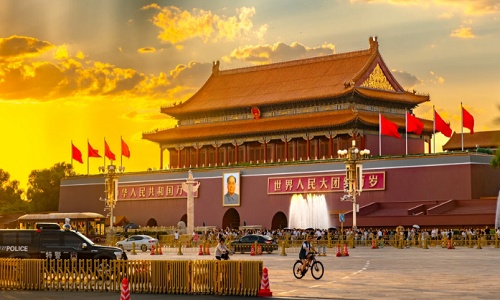
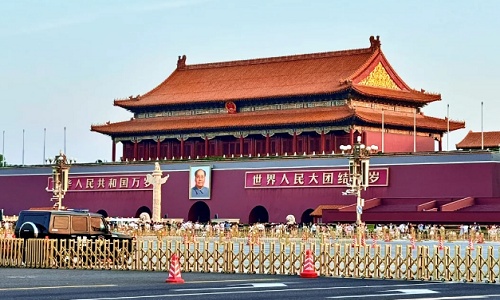
2. Forbidden City – Iconic Imperial Palace Located North of Qianmen
The Forbidden City, north of Qianmen Street, is an essential stop for history and architecture enthusiasts. As the former imperial palace of the Ming and Qing dynasties, it houses thousands of rooms, halls, and gardens, showcasing China’s imperial culture. Visitors can explore the Hall of Supreme Harmony, the Imperial Garden, and special museum exhibitions. Walking through its grand courtyards, travelers experience the scale, design, and rich historical narratives of one of the world’s most famous palaces. The palace’s intricate architecture, symbolic decorations, and hidden corners offer endless opportunities for photography, storytelling, and deep cultural appreciation, making it a highlight of any Beijing visit. Additionally, guided tours provide fascinating anecdotes about court life, ceremonial traditions, and the daily routines of emperors, adding layers of historical context that enrich the overall experience.
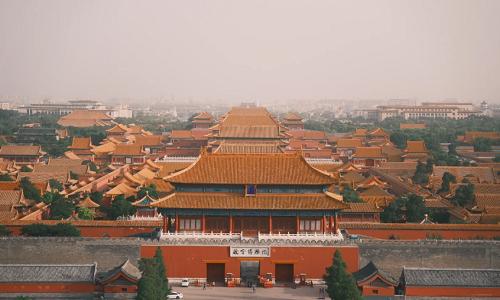
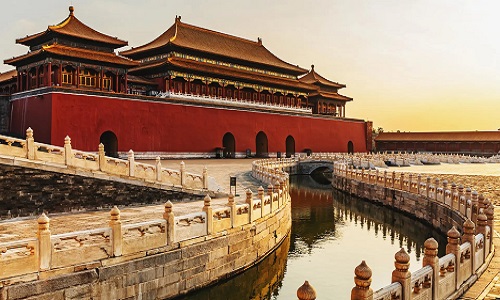
3. Dashilan Hutong – Explore Traditional Alleys, Crafts, and Cafés
Dashilan Hutong, a short stroll from Qianmen, offers an authentic glimpse into Beijing’s historic alleyway life. Here, visitors can wander narrow lanes lined with traditional courtyard homes, discover local crafts, and enjoy quaint cafés and teahouses. The hutong reflects the social and cultural lifestyle of old Beijing, with shops selling souvenirs, handicrafts, and traditional snacks. Walking these alleys provides an immersive experience where travelers can interact with local artisans, sample homemade treats, and observe daily life as it has unfolded for centuries. Beyond shopping and dining, visitors can witness traditional ceremonies, watch artisans at work, and explore hidden side streets where centuries-old architecture is preserved. These unique encounters make Dashilan Hutong a vibrant cultural stop that bridges Beijing’s past and present, ideal for travelers seeking both history and everyday city life.


4. Temple of Heaven (Tiantan) – Magnificent Historic Temple Complex and Peaceful Park
Located southeast of Qianmen Street, the Temple of Heaven is a UNESCO World Heritage site known for its striking architecture and spiritual significance. The complex includes the Hall of Prayer for Good Harvests, the Circular Mound Altar, and beautifully landscaped parklands. Visitors can observe locals practicing tai chi, flying kites, or participating in traditional rituals. The Temple of Heaven offers both cultural insights and a peaceful retreat from the city’s bustle, making it an ideal stop on a full-day tour from Qianmen Street. Its expansive grounds, harmonious design, and seasonal landscapes allow travelers to relax, reflect, and fully appreciate Beijing’s historic and spiritual heritage. Additionally, the site provides excellent opportunities for photography, with vibrant colors, symmetrical layouts, and scenic views in every season. Guided tours often explain the symbolic significance of architectural details and ceremonial spaces, enriching visitors’ understanding of the complex’s profound cultural and historical importance.
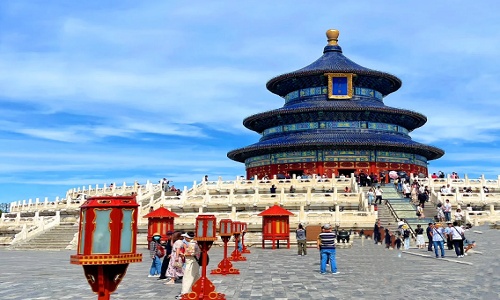
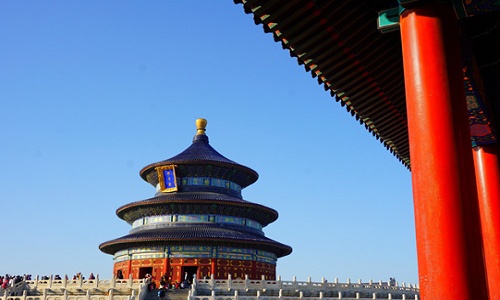
How to Get to Qianmen Street
1. By Subway – Qianmen Station (Line 2 and Line 8)
The most efficient way to reach Qianmen Street is via the subway. Qianmen Station, served by Lines 2 and 8, is just a short walk from the street’s main entrances. Subway travel avoids traffic congestion and is cost-effective for solo travelers or families. Upon exiting the station, signage and maps make it easy to navigate toward the street and nearby attractions. Travelers can also combine the subway journey with a walking tour, exploring historical landmarks along the way. Early morning or late afternoon subway trips are ideal for avoiding crowds, providing a smoother start to your Qianmen adventure.
2. By Taxi or Ride-Hailing – Convenient from Central Beijing Hotels
For those seeking a more direct and comfortable route, taxis or ride-hailing services offer convenient door-to-door access to Qianmen Street. From most central Beijing hotels, travel takes only 10–20 minutes, depending on traffic. This option is especially useful for families, travelers with limited mobility, or those carrying shopping bags. Drivers are familiar with major tourist areas, and using a ride-hailing app ensures smooth communication. Arriving by car also allows flexibility to adjust your schedule and combine visits to nearby attractions without worrying about subway transfers or walking long distances in the city heat or cold.
3. Private Tour Option – Guided Walking Tour with Cultural Insights
Joining a private walking tour offers a richer, more immersive experience of Qianmen Street. Guides provide historical context, cultural stories, and insider tips on the best shops, local snacks, and hidden corners. Walking tours often include stops at Dashilan Hutong, Zhengyangmen Gate, and other nearby landmarks, offering a comprehensive perspective on the street’s history and modern evolution. Private tours can be customized for families, history enthusiasts, or photography-focused travelers. This option ensures you don’t miss key points of interest and allows a more relaxed pace, perfect for learning about Beijing’s urban development and traditional lifestyle.
4. Tips for First-Time Visitors on Route, Timing, and Avoiding Crowds
For first-time visitors, timing is key to making the most of Qianmen Street. Early mornings or weekday visits provide a more peaceful experience, with fewer tourists and easier access to shops and eateries. Avoiding public holidays and peak weekend hours helps prevent congestion, especially near popular gates and scenic spots. Comfortable walking shoes are recommended, as exploring the street and surrounding alleys involves significant walking. Bringing water, a hat, or an umbrella ensures comfort in any season. Planning a route that combines nearby attractions like Tiananmen Square and the Temple of Heaven allows for an efficient and enjoyable day exploring the heart of Beijing’s historic core.
Best Time to Visit
1. Weekdays for a More Relaxed Experience
If you prefer strolling at your own pace, weekdays are ideal. The street is less crowded, allowing you to enjoy the historic architecture, browse boutique shops, and take photos without jostling crowds. Early mornings are especially peaceful, perfect for capturing the traditional charm before the hustle begins.
2. Evening Hours for Illuminated Streets and Street Performances
Qianmen Street truly comes alive after dark. Lanterns, LED lights, and shopfronts illuminate the street, creating a magical atmosphere. Street performers, traditional musicians, and acrobats often entertain visitors in the evening, making it a perfect time for both cultural immersion and photography.
3. Major Festival Seasons for Special Cultural Events
If you want a taste of Beijing’s vibrant culture, plan your visit around major festivals. During Chinese New Year, Mid-Autumn Festival, or National Day, Qianmen Street hosts traditional performances, folk art displays, and seasonal decorations. It’s a lively time to experience local customs, sample festival snacks, and join the celebrations.
Travel Tips
1. Wear Comfortable Shoes
Qianmen Street is best experienced on foot, as its charm lies in the details you notice while strolling slowly—ornate historical façades, traditional shops, and vibrant street life. Meandering through the alleyways allows you to appreciate the mix of old and new, from centuries-old architecture to modern boutique stores. Comfortable shoes are essential because the street is long, and walking from one end to the other while exploring side streets can take hours. High heels or stiff footwear will quickly become uncomfortable, especially if you want to stop frequently for photos, snacks, or souvenir shopping. Think of your shoes as your ticket to a relaxed and immersive experience.
2. Carry Essentials
A small backpack is your best companion when exploring Qianmen Street. Carrying water is essential, particularly in warm weather, to stay hydrated while walking around. Light layers are recommended because temperatures can change quickly between the sunlit street and shaded alleys. Sunglasses, a hat, or even a compact umbrella can help with both sun and unexpected rain. Having a bag also allows you to collect souvenirs and snacks without worrying about juggling purchases. Snacks like candied fruits or local pastries are perfect for trying on the go, and keeping your hands free lets you snap photos of street performers, architecture, and intricate details that might otherwise be missed.
3. Check Store Hours and Performance Schedules
Many shops on Qianmen Street open and close at varying times, and some traditional craft stores may only operate in the afternoons. Likewise, street performances often follow specific schedules, especially in the evenings, and missing them can mean missing a truly unique cultural experience. By checking store hours and performance times ahead of your visit, you can plan a smooth route and maximize your time. Certain seasonal events or festivals may also have temporary stalls or performances that are worth catching. Planning ahead not only saves time but allows you to prioritize attractions that interest you most, making your visit richer and more enjoyable.
4. Respect Local Customs and Pedestrian Zones
Qianmen Street is not only a bustling commercial area but also a treasured cultural landmark. Being mindful of local customs is key: avoid blocking performers or shop entrances, and follow pedestrian pathways to ensure smooth movement for everyone. Many areas are shared by tourists, local shoppers, and street performers, so keeping a respectful distance enhances everyone’s experience. Observing local etiquette—such as queuing politely at popular stalls or not touching delicate displays—helps preserve the historical charm of the street. By respecting both people and the environment, you contribute to a pleasant atmosphere that allows visitors and locals alike to enjoy the unique vibrancy of Qianmen Street.
Fun Facts & Little-Known Secrets
Qianmen Street is not just a shopping destination—it’s a living museum of Beijing’s history, filled with hidden gems and fascinating stories. Once the busiest commercial street outside the palace walls, it served as the heart of trade, culture, and daily life in old Beijing. Today, wandering through its narrow alleyways reveals centuries-old crafts, antique shops, and specialty stores that have been passed down through generations. Many buildings still preserve their original Qing Dynasty architecture, offering visitors a glimpse into the city’s past and the intricate craftsmanship of that era. Local legends abound, from tales of famous merchants who once thrived here to stories of residents whose lives shaped the street’s unique character. Beyond history, there are small courtyards tucked behind busy façades, traditional snack shops that have served generations, and artisans practicing age-old techniques. Each corner tells a story, from faded teahouse signs to ornate doorway carvings. Exploring Qianmen Street is like stepping back in time, where every twist and turn reveals secrets waiting to be discovered, blending history, culture, and the vibrant energy of modern Beijing into one unforgettable experience.
Cultural Reflection & Visitor Experience
Visiting Qianmen Street offers more than sightseeing—it’s a chance to experience the seamless blend of Beijing’s rich history with its modern lifestyle. Walking along these streets, you traverse paths that have witnessed centuries of change, from the bustling markets of the Qing Dynasty to the contemporary shops and cafés that now line the avenue. Each building, alleyway, and shopfront tells a story of cultural continuity, showing how tradition and modernity coexist harmoniously. Visitors can observe the fusion of commerce, architecture, and local customs, from centuries-old storefronts to artisans practicing age-old crafts alongside contemporary businesses. Qianmen Street invites reflection on the city’s evolving identity, offering a tangible connection to Beijing’s past while showcasing the vibrant energy of its present. It’s a place to not just see, but to feel the living heritage of the city and appreciate how cultural traditions continue to thrive in everyday life.
Savor the Best of Beijing’s Qianmen Street with Curated Tours by Your Way Holiday
We design private and Tailor-made Beijing Tours customized to your style of travel at affordable local prices. We will provide a private & spacious car and a local professional tour guide with over 5 years guiding experience only work for you or your group. Transport, ticket, and dining (We find the most authentic dishes popular with locals) all we will arrange for you according your requirements. Please check our most popular tours below:
Are the above sample tour programs not suitable for you? Dont worry, our Beijing tours can be tailor-made based on your requirements and budget to create unique Beijing experiences that allow you to interact with the local people and culture. We are Beijing travel experts who know what your guidebook and foreign agencies don't. Our enthusiastic tour expert will promptly reply you in details within 24 hours.
Duration:7-8 Hours
Attractions(Cities):Tiananmen Square, Forbidden City, Temple of Heaven, Summer Palace
Tour Style:Experience the heart of Beijing on this one-day tour, designed to immerse you in the city’s rich history, culture, and beauty. Visit iconic landmarks such as Tiananmen Square, the Forbidden City, the Temple of Heaven, and the Summer Palace. Each site offers a unique glimpse into China’s imperial past, with expert guides sharing captivating stories and insights that bring history to life. As you explore, you’ll gain a deeper understanding of Beijing’s cultural heritage, from its grand palaces to its tranquil gardens. This Beijing tour offers personalized service, ensuring a comfortable and seamless experience. Whether you're a first-time visitor or returning to explore more, this tour is the perfect way to discover Beijing’s timeless treasures in a single, unforgettable day.
Duration:2 Days, 1 Night
Attractions(Cities):Temple of Heaven, Tiananmen Square, Forbidden City, Nanluoguxiang, Mutianyu Great Wall, Summer Palace
Tour Style:Embark on a fascinating 2-day adventure in Beijing, where history and modernity blend seamlessly. Begin with the majestic Temple of Heaven and the iconic Tiananmen Square, before discovering the grandeur of the Forbidden City, an imperial treasure trove. Explore the lively Nanluoguxiang, where traditional architecture meets vibrant city life. On day two, enjoy breathtaking views from the Mutianyu Great Wall, a marvel of ancient engineering, and immerse yourself in the serene beauty of the Summer Palace, with its lush gardens and elegant pavilions. This thoughtfully crafted tour offers the perfect mix of historical insights and cultural experiences, designed to captivate your senses and spark your curiosity, leaving you with lasting memories of Beijing.
Duration:3 Days, 2 Nights
Attractions(Cities):Tiananmen Square, Forbidden City, Temple of Heaven, Jingshan Park, Summer Palace, Kunming Lake Boat Riding, Nanluoguxiang, Panjiayuan Antique Market, Mutianyu Great Wall, Bird's Nest, Water Cube
Tour Style:Immerse yourself in Beijing’s rich history and vibrant culture with our exclusive 3-day private tour. Start by exploring Tiananmen Square and the majestic Forbidden City, then visit the serene Temple of Heaven. Enjoy sunset views from Jingshan Park and a scenic boat ride on Kunming Lake at the Summer Palace. Wander through the lively Nanluoguxiang Hutong, hike the breathtaking Mutianyu Great Wall, and marvel at the modern Bird’s Nest and Water Cube. This personalized tour seamlessly blends historical landmarks, cultural experiences, and stunning architecture, ensuring an unforgettable journey. Every moment is designed to captivate, inspire, and leave you with lasting memories of Beijing’s unique charm and diverse beauty.
Duration:5 Days, 4 Nights
Attractions(Cities):Mutianyu Great Wall, Bird's Nest, Water Cube, Qianmen Street, Morning Market, Forbidden City, Tiananmen Square, Jingshan Park, Temple of Heaven, Nanluoguxiang, Facial Makeup Painting, 798 Art Zone
Tour Style:Immerse yourself in Beijing’s rich culture and history with our comprehensive Beijing tour package. This thoughtfully crafted itinerary takes you to iconic landmarks such as the Mutianyu Great Wall, Forbidden City, and Tiananmen Square, alongside modern architectural wonders like the Bird’s Nest and Water Cube. Experience local life at Qianmen Street and the Morning Market, and discover the city’s vibrant art scene at the 798 Art Zone. Engage in hands-on activities, including traditional facial makeup painting. With expert guidance from a seasoned Beijing travel expert, this tour seamlessly combines historical exploration with cultural immersion, offering an unforgettable Beijing experience. Each moment is designed to leave you with lasting memories of this dynamic city.
Duration:10+ Hours
Attractions(Cities):Terracotta Warriors and Horses Museum
Tour Style:Embark on a captivating day trip from Beijing to Xi'an to explore the iconic Terracotta Warriors. This Beijing-Xi'an tour offers a fascinating journey through ancient Chinese history, highlighting the world-renowned Terracotta Army. Visit this monumental archaeological site, home to thousands of life-sized soldiers, horses, and chariots, each crafted with intricate details. With the guidance of an expert, learn about the historical significance of these remarkable figures and their role in China’s ancient imperial past. Enjoy seamless travel and smooth logistics, ensuring a stress-free experience as you delve into the history and culture of this extraordinary site. This day trip promises an enriching and memorable exploration of one of China’s most treasured landmarks.
Wechat: Chinaprivatetour
24 Hours Hotline:
+86 137-3541-1378
(Your Privacy is Protected)
1 to 1 tailor-made service from our professional travel advisors for the most sophisticated
Constantly excellent reviews for attraction, hotel and service Competitive price
Local experts provide quality tours Best selected knowledgeable local guides Authentic local restaurants
7*24 hours available to create you a worry-free tour. No Hidden Fees and absolutely no pressure to buy. Secured









Copyright © 2017 Chinabeijingprivatetour.com All rights reserved. 浙ICP备18056007号-2